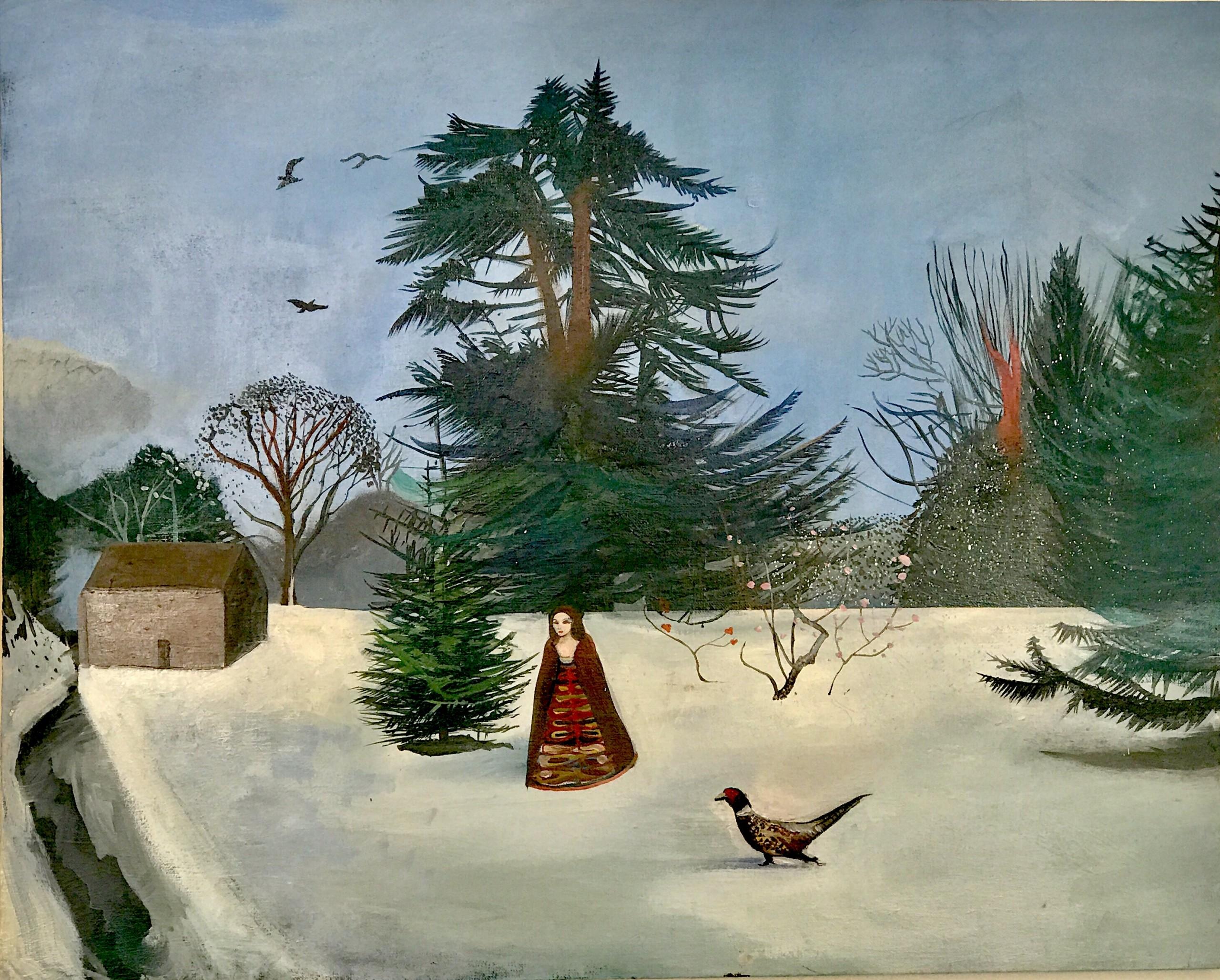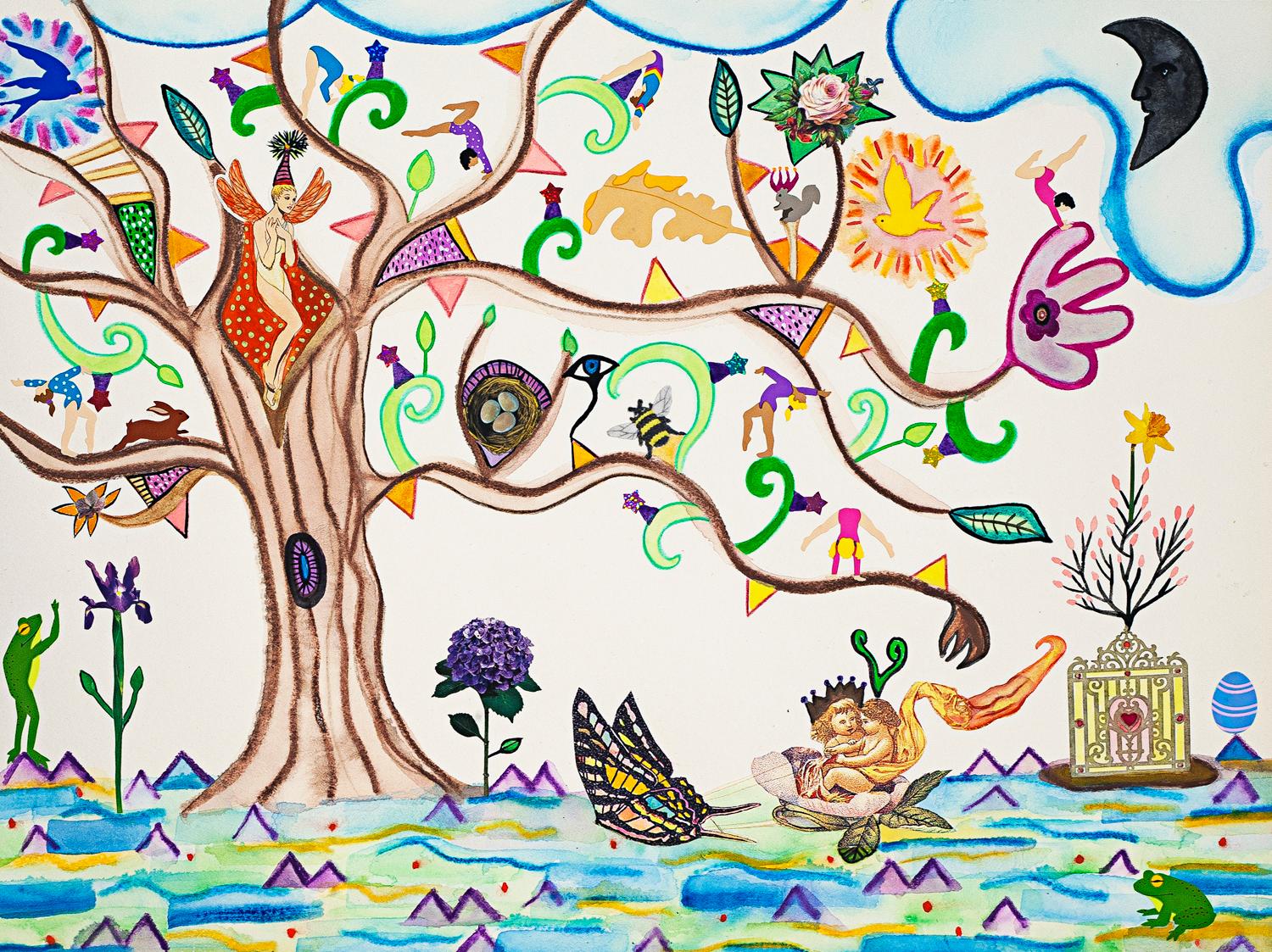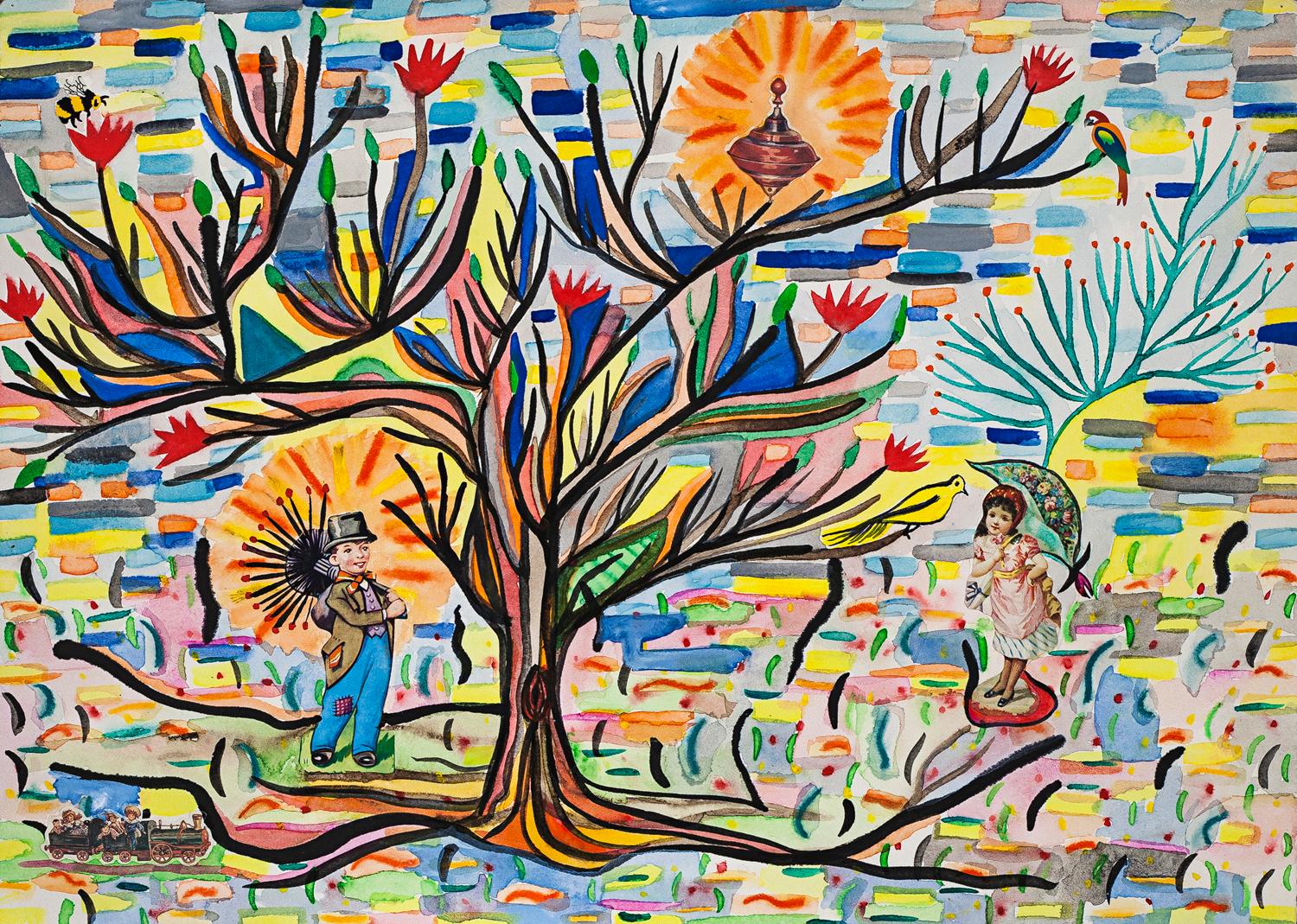Items Similar to "Anthropomorphic Figure, " Ink and Gouache Painting by Unknown African Artist
Want more images or videos?
Request additional images or videos from the seller
1 of 7
Unknown"Anthropomorphic Figure, " Ink and Gouache Painting by Unknown African ArtistUnknown
Unknown
About the Item
"Anthropomorphic Figure" is an original ink and gouache on handmade paper by an unknown African artist. It depicts a human-snake figure.
33 1/2" x 19" art
55 1/2" x 33" frame
- Creation Year:Unknown
- Dimensions:Height: 55.5 in (140.97 cm)Width: 33 in (83.82 cm)
- Medium:
- Period:
- Condition:
- Gallery Location:Milwaukee, WI
- Reference Number:
About the Seller
4.9
Platinum Seller
These expertly vetted sellers are 1stDibs' most experienced sellers and are rated highest by our customers.
Established in 1966
1stDibs seller since 2017
393 sales on 1stDibs
Typical response time: 2 hours
- ShippingRetrieving quote...Ships From: Milwaukee, WI
- Return PolicyA return for this item may be initiated within 14 days of delivery.
More From This SellerView All
- Kees Van Dongen Circus Performers 1900s Vintage Vibrant Figure Fauvist SignedBy Kees van DongenLocated in Milwaukee, WI"Les Artistes du Cirque" is an original painting in ink, watercolor, and gouache on paper by leading Fauvist artist Kees Van Dongen, signed in the lower right. In the piece, two circus performers stand against against a wall. On the left, a pale woman in a blue leotard with red flowers on the shoulder stands with her arms crossed, looking out at the viewer. The painter fills in her tights with delicate white brushstrokes, lending them an almost iridescent appearance. Her strawberry blond hair is piled on top of her hair according to the fashion of the period. On the right, an African man stands in a vivid orange toga, looking somewhere off to the left. His feet are clad in bright white shoes...Category
Early 1900s Fauvist Figurative Paintings
MaterialsPaper, Ink, Watercolor, Gouache
- Vielle Femme en Petite CapeBy Jacques VillonLocated in Milwaukee, WISigned with stamp, J.V. 7-5/8" x 4-3/4" art 19" x 15-1/4" frame Jacques Villon (French, 1875 - 1963) French painter, printmaker and illustrator. The oldest of three brothers who became major 20th-century artists, including Raymond Duchamp-Villon and Marcel Duchamp, he learnt engraving at the age of 16 from his maternal grandfather, Emile-Frédéric Nicolle (1830-94), a ship-broker who was also a much appreciated amateur artist. In January 1894, having completed his studies at the Lycée Corneille in Rouen, he was sent to study at the Faculty of Law of the University of Paris, but within a year he was devoting most of his time to art, already contributing lithographs to Parisian illustrated newspapers such as Assiette au beurre. At this time he chose his pseudonym: Jack (subsequently Jacques) in homage to Alphonse Daudet’s novel Jack (1876) and Villon in appreciation of the 15th-century French poet François Villon...Category
Early 1900s Impressionist Figurative Paintings
MaterialsIndia Ink, Gouache
- "Sledding by the Big Tree, " Colorful Mixed Media Collage Painting by Dan MullerBy Dan MullerLocated in Milwaukee, WI"Sledding by the Big Tree" is an original mixed media piece by Dan Muller. The artist used cut & pasted paper, watercolor, and pastel to create this colorful work. The artist signed the piece lower left. This artwork features four children sledding...Category
2010s Contemporary Mixed Media
MaterialsPaper, Pastel, Mixed Media, Watercolor
- 'Greek Urn' original mixed media painting signed by Catherine HolmburgBy Catherine HolmburgLocated in Milwaukee, WIIn this painting, Catherine Holmburg presents a modern interpretation of a seventeenth-century still life on a monumental scale. The painting includes classical subjects, including a...Category
Early 2000s Contemporary Still-life Paintings
MaterialsMixed Media, Oil, Acrylic, Watercolor
- "Houses at Night, " Colorful Mixed Media Collage on Paper signed by Dan MullerBy Dan MullerLocated in Milwaukee, WI"Houses at Night" is an original mixed media painting by Dan Muller. The artist signed the piece lower right. The artist used cut & pasted paper, waterc...Category
2010s Contemporary Mixed Media
MaterialsPaper, Pastel, Mixed Media, Watercolor
- Persian Illuminated Miniature with Three Hunters on Horseback in a LandscapeLocated in Milwaukee, WIThe present illuminated folio page contains a fine miniature depicting three figures hunting while on horseback, an image meant to accompany a historic epic. During the medieval period, hunting was an important pastime of male nobility throughout the Islamic world. The Quran itself explicitly endorses hunting and the use of animals to aid in capturing prey: "Lawful to you are foodstuffs that are good to eat and any game that, at your wish, is captured by beasts of prey which train as you do dogs, according to the method that Allah has taught you, after you have spoken the name of Allah over it." (Q 6:4) Muslim princes and nobles enjoyed the chase of the prey via horseback, using bow and arrow, crossbows, and blowpipes to capture their prey Horseback riding itself trained young men in the necessary skills for armed combat and warfare, developing their speed and strength. 12 x 8.25 inches, artwork 19.75 x 15.88 inches, frame accompanied on the back with an image of the verso framed to conservation standards with a 100% rag silk-lined mat in a gold gilded frame A Persian miniature is a small Persian painting on paper, whether a book illustration or a separate work of art intended to be kept in an album of such works called a muraqqa. The techniques are broadly comparable to the Western and Byzantine traditions of miniatures in illuminated manuscripts. Although there is an equally well-established Persian tradition of wall-painting, the survival rate and state of preservation of miniatures is better, and miniatures are much the best-known form of Persian painting in the West, and many of the most important examples are in Western, or Turkish, museums. Miniature painting became a significant genre in Persian art in the 13th century, receiving Chinese influence after the Mongol conquests, and the highest point in the tradition was reached in the 15th and 16th centuries. The tradition continued, under some Western influence, after this, and has many modern exponents. The Persian miniature was the dominant influence on other Islamic miniature traditions, principally the Ottoman miniature...Category
19th Century Other Art Style Figurative Paintings
MaterialsInk, Tempera, Laid Paper
You May Also Like
- The New Colossus, Still (#2248)By Jack BalasLocated in New York, NYThe New Colossus, Still (#2248) 2023 Signed, titled, and dated, verso India ink, watercolor, and gouache on paper 30 x 22 inches This painting by ...Category
2010s Contemporary Paintings
MaterialsGouache, Watercolor, India Ink, Paper
- The PheasantBy Daisy ClarkeLocated in Deddington, GBDaisy Clarke The Pheasant Original Landscape Painting Ink and Gouache on Paper Size: H 61cm x W 77cm x D 0.1cm Sold Unframed (Please note that in situ ima...Category
21st Century and Contemporary Contemporary Figurative Paintings
MaterialsPaper, Ink, Gouache
- Americana Farmer and Wife, Gouache Painting WPA Art William Gropper WoodchopperBy William GropperLocated in Surfside, FLWilliam Gropper Original Gouache on Paper depicting man carrying an axe and woman carrying basket walking together. Hand signed lower right Fra...Category
Mid-20th Century Modern Figurative Paintings
MaterialsInk, Watercolor, Gouache
- Americana, Lawyer in Court, Politician, Gouache Painting WPA Art William GropperBy William GropperLocated in Surfside, FLWilliam Gropper Original Gouache on Paper Hand signed lower right 33.5 x 27.5 image 26 x 20.5 The New-York born artist William Gropper was a painter and cartoonist who, with caricature style, focused on social concerns, and was actively engaged in support of the organized labor movement throughout his career. This original watercolor drawing is done in the iconic style of the artist's oeuvre. Born to Harry and Jenny Gropper in 1897, William was raised in New York City's Lower East Side. His parents were Jewish immigrants from Romania and Ukraine, and young William grew up in relative poverty, watching his family struggle to achieve that sought-after American dream. His father, a bright and college-educated man, was unable to find employment that worthy of his intellect. His mother, meanwhile, worked as a seamstress from home. Coupled with the devastating loss of an aunt to the infamous Triangle Factory fire of 1911, significant childhood factors created the foundation that led to Gropper’s exploration of the American experience. Early on, Gropper displayed an extraordinary, natural skill for art. By 1912, he was already studying under the instruction of George Bellows and Robert Henri at the Ferrer School in Greenwich Village. During his time at school, Gropper was also awarded a prestigious scholarship to study at the National Academy of Design. However, he refused to fit into convention and was swiftly expelled from the Academy. After his expulsion, Gropper returned home to help financially by assisting his mother and taking a shop position. However, he didn't abandon art academia and soon presented a portfolio to the New York School of Fine Art which earned him a scholarship for study. Gropper obtained his first significant job as a cartoonist for the New York Tribune in 1917. While working as a staff cartoonist for the Tribune, he also contributed drawings to publications like Vanity Fair, New Masses, The Nation, and Freiheit. His interest in the welfare of the American worker, class inequality, and social injustice was central in his work. After publishing the graphic novel Alley Oop in 1930, Gropper's illustration career extended well into the decade. However, he was never exempt from controversy, and his 1935 Vanity Fair cartoon; prompted anger from the Japanese government. As an involved labor organizer and Social Realist activist, Gropper continued to bring attention to his radical reputation with visits to the Soviet Union and Poland. However, his concern with European politics and U.S. social causes didn't slow down his artistic career, and by the late 1930s, he had produced significant murals for American cities like Washington D.C. His 1938 mural Construction of a Dam was commissioned for the Department of the Interior and represents the Social-Realism style that depicts experiences of the worker and everyday societal life. Measuring at a staggering 27ft by 87ft, the piece portrays muscular, robust American laborers scaling rocky hillsides, building infrastructure, and operating heavy machinery. The mural feels undeniably American with golden scenery, denim blues, and steely gray colors. Gropper fits perfectly into Social-Realism because the style exhibits an illustrative flair with strong lines and simple, bold hues. The inspiration for Construction of a Dam sprang from his 1937 travels to the poverty-stricken Dust Bowl area. The trip was sponsored by a Guggenheim Foundation Fellowship, and his drawings of the Grand Coulee and Boulder Dams...Category
Mid-20th Century Modern Figurative Paintings
MaterialsInk, Watercolor, Gouache
- Susan Bee, Winged Fairies, 2006, gouache, collage, ink, crayon, colored pencilBy Susan BeeLocated in Darien, CTSusan Bee's drawings are made up of collage elements including children’s stickers and imagery, ink, gouache, watercolor, crayon, and colored pencil. The richness of the imagery in ...Category
Early 2000s Feminist Figurative Paintings
MaterialsCrayon, Ink, Watercolor, Gouache, Archival Paper, Synthetic Paper, Color...
- Susan Bee, Girl With Umbrella, 2003, gouache, collage, ink, colored pencilBy Susan BeeLocated in Darien, CTSusan Bee's drawings are made up of collage elements including children’s stickers and imagery, ink, gouache, watercolor, crayon, and colored pencil. The richness of the imagery in ...Category
Early 2000s Feminist Figurative Paintings
MaterialsCrayon, Ink, Watercolor, Gouache, Archival Paper, Synthetic Paper, Color...
Recently Viewed
View AllMore Ways To Browse
Unknown Vintage
20th Unknown
Vintage African Painting
20th Century Africa Paintings
Anthropomorphic Art
African Art Unknown Artist
Anthropomorphic Vintage
African Gouache
Snake Ink
Snake Africa
Vintage Snake Painting
Painting Frame 55x33
Oil Painting Resting Woman
Oil Painting Cardinal
Surrealist Sea
Wes Hunting
Dutch Girl
Impressionist Ballet





